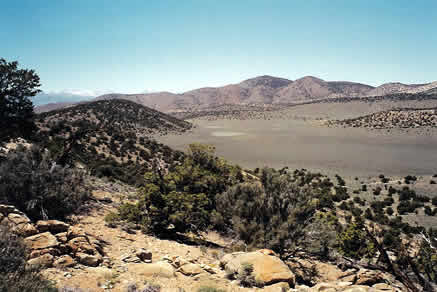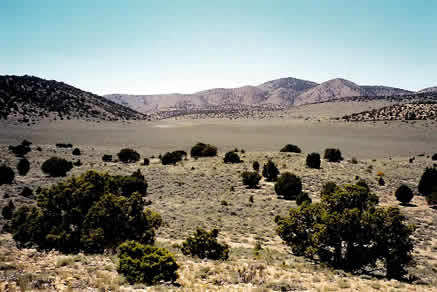 |
View of Juniper Flat (looking west) from the ridge to the south of Juniper Flat. Snowy peaks in the far horizon are in the Sierra Nevada. The highest peak visible in the Inyo Mountain skyline is the site of the proposed microwave relay station. |
|
The project
Bristlecone Chapter's position
| At the Bristlecone Chapter Board of Directors Meeting of September 18,
2001, the Board formally adopted a resolution opposing any management practice which would
compromise the ecological integrity of Juniper Flat. Because the proposed road and
observatory construction would certainly compromise the area a letter was drafted to be
sent to Inyo National Forest Supervisor Jeff Bailey asking that he not accept CARMA's
application for the needed Special Use Permit. The Board's view is that the issues at Juniper Flat are almost identical to those at Uppr Harkless Flat. The limestone ridges surrounding Juniper Flat are the habitat for numerous CNPS-listed species (six were counted in a very brief walk in July, 2001). Extensive cryptogamic soil crusts were observed and no significant weed infestations or grazing impacts were observed. The vegetation of limestone/dolomite mountains of California has not been adequately described or studied and represents and one of eastern California's distinct contributions to the state's biodiversity. Juniper Flat is an intact, largely undisturbed ecosystem in the middle of a much larger undisturbed area (it adjoins the Piper Mountain wilderness). The proposed construction of both large access road and observatory would not only disturb Juniper Flat itself, but also increase fragmentation of the surrounding area. These are not impacts which can be adequately mitigated. The Inyo Mountains cannot be re-created elsewhere. With California's population continuing its uncontrolled growth, large, intact ecosystems are becoming ever more rare, especially those with high proportions of uncommon species. Under current management, the poor condition of the Juniper Flat access road provides de facto protection to the area. Juniper Flat is used by ORV riders, hunters, campers, hikers, mountain bikers, bird-watchers, plant-lovers, as well as researchers in biology and geology. Under current management Inyo National Forest is carrying out both its mandate for sustaining native biodiversity and it mandate for multiple use. The proposed construction would be incompatible with these mandates. AlternativesThe Draft Environmental Impact Statement (DEIS) was released in April, 2003.
There are three alternatives: The Bristlecone Chapter of CNPS strongly supports the decision to move the preferred alternative away frm Juniper Flat. What you can do...1) Comment on the DEIS: Comments on the DEIS will be accepted
until June 23, 2003. Comments received on or before June 23, 2003 must
be addressed in the Final Environmental Impact Statement. Because Inyo National
Forest is moving its office during the comment period send comments before June 1 to: After June 1, send comments to Mr. Jeff Bailey For more information about the project proposal, the EIS/EIR process, please call Chaz O’Brien at 760/ 873-2490, or Nancy Upham, Public Affairs Officer, at 760/ 873-2427. 3): Visit the area yourself. See the map and instructions below. |
|
View from Juniper flat looking northwest |


